In this section you will learn to:
- Evaluate how the relationship between different body systems affect and support healthy functioning
Supplementary materials relevant to this section:
- Reading G: Convulsions in Children
- Reading H: Medical Assistance in the War Against Pathogens
The previous section of this Study Guide provided you with an overview of the basic structure and functions of the body systems. We looked at the associated components within these systems and how they are all interrelated in order to support the body. In this Study Guide we will identify the specific body systems that supports and affect this process of healthy functioning.
You may have heard mammals described as ‘warm-blooded’. A better word for this is that they are homeotherms. This means that they keep their body temperature constant, despite changes in the temperature of their surroundings. What is the advantage of a human maintaining a body temperature of 37 °C? It means that all the chemical reactions taking place in the cells of the body can go on at a steady, predictable rate. A human’s metabolism does not slow down in cold environments.
The integumentary system
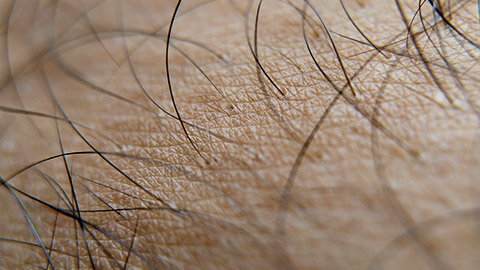
The integumentary system consists of the skin and associated structures such as hairs, sweat glands, oil and nails, for the maintenance of body temperature we will mainly focus on the skin and its function.
The skin
The human skin is the outer surface of the body, and has a number of functions including:
- forming a tough outer layer able to resist mechanical damage
- acting as a barrier to the entry of disease-causing microorganisms
- forming an impermeable surface, preventing loss of water
- acting as a sense organ for touch and temperature changes
- controlling the loss of heat through the body surface.
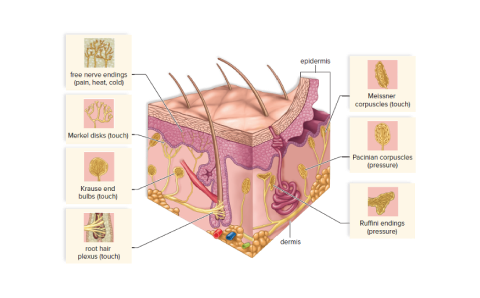
It is made up of three layers:
- the epidermis - consists of dead cells that stop water loss and protect the body against invasion by microorganisms such as bacteria.
- hypodermis - contains fatty tissue, which insulates the body against heat loss and is a store of energy.
- dermis - contains many sensory receptors. It is also the location of sweat glands and many small blood vessels, as well as hair follicles, which stand on end to trap heat.
Reading
Reading H: Convulsions in Children with Covid-19
Reading H is an examination of three children at the age of four who had accidentally been presented to the Swedish children’s hospital with convulsions due to high body temperatures and contracting Covid-19.
The human circulatory system is made up of the following parts:
- The heart: a muscular pump.
- Blood vessels: these carry the blood around the body. Arteries carry blood away from the heart and towards other organs. Veins carry blood towards the heart and away from other organs. Capillaries carry blood through organs, linking the arteries and veins.
- Blood: the transport fluid.
The beating of the heart sends blood into the blood vessels. In humans, blood is always contained within blood vessels. Blood is pumped around a closed circuit made up of the heart and blood vessels. As it travels around the body, it collects materials from some places and unloads them in others. In mammals, blood transports:
- oxygen from the lungs to all other parts of the body
- carbon dioxide from all parts of the body to the lungs
- nutrients from the gut to all parts of the body
- the excretory waste product urea from the liver to the kidneys.
Tip
To work properly, your heart needs a continuous supply of oxygen-rich blood. It normally receives this from blood vessels called coronary arteries. When a coronary artery suddenly becomes completely blocked, oxygen can’t get to your heart muscle — which causes a heart attack (or, ‘myocardial infarction’). Heart attack is a medical emergency: without oxygen, the muscle begins to die, and your heart can become permanently damaged.
Blood also transports hormones, antibodies, and many other substances. It distributes heat around the body and contains cells and cell products that defend the body against microorganisms that cause disease.
There are two parts to a double circulatory system:
-
The pulmonary circulation: Deoxygenated blood leaves the heart through the pulmonary arteries. It is circulated through the lungs, where it becomes oxygenated. The oxygenated blood returns to the heart through the pulmonary veins.
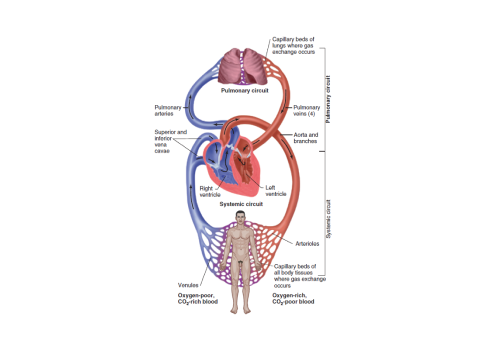
-
The systemic circulation: Oxygenated blood leaves the heart through the aorta and is circulated through all other parts of the body, where it unloads its oxygen. The deoxygenated blood returns to the heart through the vena cava.
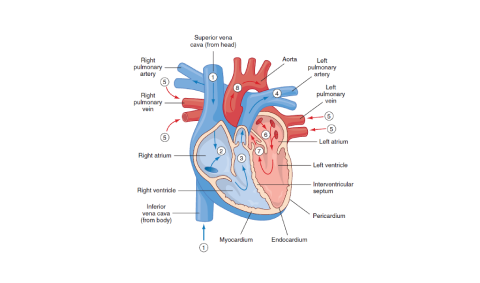
Arteries, veins, and capillaries

- Arteries carry blood from the heart to the organs of the body. This arterial blood is pumped out under high pressure by the ventricles of the heart. When blood leaves the heart through the aorta, valves in the aorta prevent the blood from returning to the heart.
- Veins carry blood from organs back to the heart. Blood pressure decreases as it flows through the capillaries, so the blood in veins (venous blood) is at a very low pressure – much lower than in the arteries.
- Capillaries carry blood through organs, bringing the blood close to every cell in the organ. Substances are transferred between the blood in the capillary and the cells. To do this, capillaries must be small enough to ‘fit’ between cells and allow materials to pass through their walls easily.
Regulation of blood pressure
Blood pressure is expressed as two measurements, the systolic pressure, and the diastolic pressure.
- The systolic pressure results from contraction of the left ventricle.
- The diastolic pressure is the pressure in the arteries when the ventricles relax. Systolic pressure is higher than diastolic pressure.
Tip
- High blood pressure, also known as hypertension, is the most important known risk factor for stroke.
- Blood pressure is a measure of the force with which blood presses on the walls of your arteries as it is pumped around your body. This pumping action is driven by your heart.
- Normal blood pressure is around 120/80. If your blood pressure is regularly over 140/90, you have high blood pressure.
- High blood pressure puts a strain on blood vessels all over the body, including the arteries that lead to the brain. This means the heart must work much harder to keep the blood circulation going.
- High blood pressure can lead to a stroke in several ways:
- It damages blood vessel walls and makes them weaker.
- It can speed up common forms of heart disease.
- It can cause blood clots or plaques to break off artery walls and block a brain artery.
- The higher the blood pressure, the greater the stroke risk.
(Stroke Foundation Australia, 2022)
Maintaining your blood pressure

There are a number of factors you can control to help reduce your blood pressure and chances of having a stroke.
- Know your blood pressure - the lower your blood pressure, the lower your risk of stroke.
- Healthy eating - enjoy a variety of foods especially plant-based foods including fresh fruit and vegetables, legumes and wholegrain breads and cereals.
- Get active - try to engage in at least 30 minutes of moderate physical activity on most days of the week. Every move counts, though being active at a higher intensity will result in a greater health benefit.
- Drop the salt - the fresher food you eat, the less salt you’ll get. Don’t add salt when you cook or when you eat. Check the salt content in all processed foods and aim for 400mg/100g of sodium or less.
- Avoid alcohol - your doctor can talk to you about alcohol and your stroke risk.
- Quit smoking - call Quitline on 13 7848 (Australia) or contact your local GP.
Homeostasis maintains a balance of substances in the body and excretion removes the waste products of metabolism. The kidneys are involved in both these processes. This section is mainly concerned with the structure and function of the kidneys.
Urinary System
This body system is responsible for removing waste and any excess fluids. The urinary or renal system removes waste from blood in the form of urine. It also helps regulate blood volume and pressure and controls the level of chemicals and salts (electrolytes) in body's cells and blood. A human has two kidneys, each of which is supplied with blood through a short renal artery. The urine passes out of the kidneys through two tubes, the ureters, and is stored in a muscular bag called the bladder.
The bladder has a tube leading out of the body, called the urethra. The wall of the urethra contains two ring-shaped muscles, called sphincter muscles. They can contract to close the urethra and hold back the urine. The lower sphincter muscle is voluntary (under conscious control), while the upper sphincter muscle is involuntary – it automatically relaxes when the bladder is full.
![[ADD IMAGE'S ALT TEXT]](/sites/default/files/Electrolyte%20Balance.png)
Tip
Excretion can be defined as ‘the process by which waste products of metabolism are removed from the body’. In humans, the main substance is urea. Another excretory product is carbon dioxide, which is produced by cell respiration and excreted by the lungs. Water is also a product of respiration, and lost from the body in urine, sweat and breath. Skin is an excretory organ, secreting small amounts of urea and salts along with the water.
Maintenance of water-salt balance
A principal function of the kidneys is to maintain the appropriate water-salt balance of the blood. The more salts there are in the blood, the greater the blood volume and the greater the blood pressure.
By regulating the concentration of certain ions, namely sodium (Na+) and potassium (K+), in the blood, the kidneys regulate blood pressure. In addition, the kidneys also maintain the appropriate blood level of other ions such as bicarbonate (HCO3 –) and calcium (Ca2+)
Maintenance of acid-base balance
The kidneys regulate the acid-base balance of the blood. For a person to remain healthy, the blood pH should be just about 7.4. The kidneys monitor and help control blood pH, mainly by excreting hydrogen ions (H+) and reabsorbing the bicarbonate ions (HCO3 –) as needed to keep blood pH at 7.4. Urine usually has a pH of 6 or lower, because our diet often contains acidic foods.
The kidneys help maintain electrolyte concentrations by filtering electrolytes and water from blood, returning some to the blood, and excreting any excess into the urine. Thus, the kidneys help maintain a balance between daily consumption and excretion of electrolytes and water.
The body has general immune responses that it uses against any microorganisms. The body also has specific immune responses which are targeted against different types of pathogens. Specific immune responses are switched on when a pathogen first enters the body.
Type of immunity
Immunity can be either active or passive, and both types of immunity can be gained naturally or artificially.
- Active immunity happens when we produce our own antibodies to an antigen. This is natural if it happens in response to an infection, and artificial if it is the result of a vaccination.
- Passive immunity is when the body does not produce its own antibodies but receives them from somewhere else. This is natural when the antibodies are received by a fetus across the placenta during pregnancy, and natural when received by a baby in its mother’s milk. It can be received artificially via the of injection of antibodies.
Reading
Reading I: Medical Assistance in the War Against Pathogens
Reading I speaks about the active and passive methods of immunisation, which help the body resist specific pathogens, and also the production of monoclonal antibodies and the discovery of antibiotics.
Lymphatic System
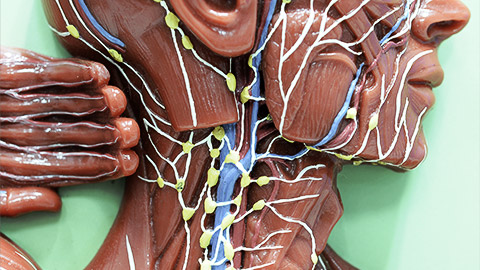
The lymphatic system is closely associated with the cardiovascular system. The lymphatic system performs three important functions:
- It helps maintain the volume of blood in the cardiovascular system.
- It transports fats and fat-soluble vitamins absorbed from the digestive system to the cardiovascular system.
- It defends the body against infection.
The basic and most important components of the lymphatic system are a network of lymph vessels throughout the body are:
- Lymph nodes – they remove microorganisms, cellular debris, and abnormal cells from the lymph before returning it to the cardiovascular system.
- Spleen – removes damaged blood cells and microorganisms from the blood
- Tonsils – it protects the throat by gathering and filtering out any microorganisms entering the throat in food or air
- Thymus - is in the chest above the heart. It stores immature lymphocytes until they mature to specialised cells (T cells) that destroy infected or cancerous cells. The thymus is only active in childhood. At puberty it becomes inactive and is replaced by fatty tissue.
Immune System

It is quite clear that the lymphatic system and immune system are closely related to the cardiovascular system.
The immune system is made up of:
- Blood is a complex tissue composed of several types of cells suspended in a liquid called plasma. Plasma transports hormones and waste products such as urea.
- Red blood cells – which transport oxygen to the lungs and unloads it in other regions of the body via haemoglobin.
- White blood cells (lymphocytes) – produces antibodies to destroy any microorganisms – some lymphocytes remain in our blood after infection and give us immunity to specific diseases.
- White blood cells (phagocytes) – digest and destroy bacteria and other microorganisms that have infected our body.
- Platelets – release chemicals to make blood clot when we cut ourselves.
Tip
Did you know?
When we are exposed to a particular disease-causing microorganism for the first time, certain lymphocytes retain a ‘memory’ of their antigens. This memory may last for many years or even a lifetime. If the same pathogen re-infects us, these memory cells can reproduce and make more antibodies. This secondary immune response is faster and stronger than the first immune response, and gives us immunity against the invading organism, so that it is killed before it can multiply to a level where it would cause the disease.
Healthy ways to strengthen your immune system
Your first line of defence is to choose a healthy lifestyle. Following general good-health guidelines is the single best step you can take toward naturally keeping your immune system working properly. Every part of your body, including your immune system, functions better when protected from environmental assaults and bolstered by healthy-living strategies such as these:
- Don't smoke.
- Eat a diet high in fruits and vegetables.
- Exercise regularly.
- Maintain a healthy weight.
- If you drink alcohol, drink only in moderation.
- Get adequate sleep.
- Take steps to avoid infection, such as washing your hands frequently and cooking meats thoroughly.
- Try to minimise stress.
- Keep current with all recommended vaccines. Vaccines prime your immune system to fight off infections before they take hold in your body.
Many products on store shelves claim to boost or support immunity. But the concept of boosting immunity actually makes little sense scientifically. In fact, boosting the number of cells in your body — immune cells or others — is not necessarily a good thing. For example, athletes who engage in "blood doping" — pumping blood into their systems to boost their number of blood cells and enhance their performance — run the risk of strokes.
Immune system and age

As we age, our immune response capability becomes reduced, which in turn contributes to more infections and more cancer. As life expectancy in developed countries has increased, so too has the incidence of age-related conditions.
While some people age healthily, the conclusion of many studies is that, compared with younger people, the elderly are more likely to contract infectious diseases and, even more importantly, more likely to die from them. Respiratory infections, including influenza, the COVID-19 virus and particularly pneumonia, are a leading cause of death in people over 65 worldwide. No one knows for sure why this happens, but some scientists observe that this increased risk correlates with a decrease in T cells to fight off infection.
A reduction in immune response to infections has been demonstrated by older people's response to vaccines. For example, studies of influenza vaccines have shown that for people over age 65, the vaccine is less effective compared to healthy children (over age 2). But despite the reduction in efficacy, vaccinations for influenza and S. pneumoniae have significantly lowered the rates of sickness and death in older people when compared with no vaccination.
There appears to be a connection between nutrition and immunity in the elderly. A form of malnutrition that is surprisingly common even in affluent countries is known as "micronutrient malnutrition." Micronutrient malnutrition, in which a person is deficient in some essential vitamins and trace minerals that are obtained from or supplemented by diet, can happen in the elderly. Older people tend to eat less and often have less variety in their diets. One important question is whether dietary supplements may help older people maintain a healthier immune system. Older people should discuss this question with their doctor.
Diet and your immune system

Like any fighting force, the immune system army marches on its stomach. Healthy immune system warriors need good, regular nourishment. Scientists have long recognised that people who live in poverty and are malnourished are more vulnerable to infectious diseases. For example, researchers don't know whether any particular dietary factors, such as processed foods or high simple sugar intake, will have adversely affect immune function. There are still relatively few studies of the effects of nutrition on the immune system of humans.
There is some evidence that various micronutrient deficiencies — for example, deficiencies of zinc, selenium, iron, copper, folic acid, and vitamins A, B6, C, and E — alter immune responses in animals, as measured in the test tube. However, the impact of these immune system changes on the health of animals is less clear, and the effect of similar deficiencies on the human immune response has yet to be assessed.
This section of the module outlines the core processes, conditions, and resources of the body in order to support healthy functioning. You learned how the body maintains and regulates its temperature and explored how waste is eliminated from the body and how the same system helps our bodies maintain its fluid and PH balance. You were also introduced to the systems responsible for fighting any infections or diseases from our bodies. Remember it is important as you identify and understand these body systems to also comprehend their interrelationship to support our bodies and its healthy functioning. In the next section, we will look at factors that contribute to keeping these body systems healthy.
